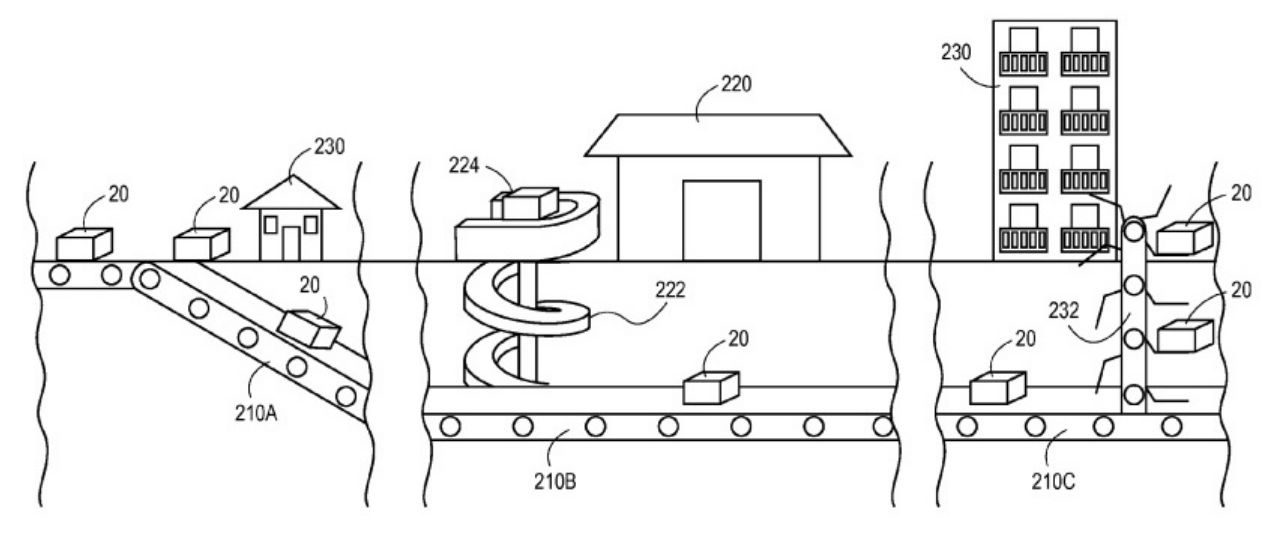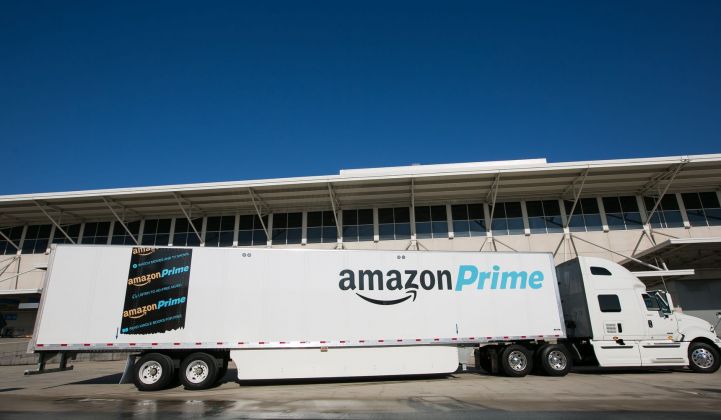Autonomous drones apparently aren't exciting enough for Amazon, so the online retail giant has also started work on developing self-driving vehicle technology for use on the ground.
The U.S. Patent and Trademark Office has just granted Amazon a patent related to the coordination of autonomous vehicles on a roadway with reversible lanes. Say it’s rush hour and the lane directions over a bridge have changed -- it’s probably a good idea for the vehicle to know.
Amazon’s proposed roadway management system is designed to monitor traffic flow and generate routing instructions for self-driving cars based on the roadway assignment. The central network would be able to give vehicles advance warning, instead of relying on visual cues to make a real-time decision.

Amazon illustration via USPTO
The benefits of this technology could improve autonomous driving beyond lane management. Road Show reports, “Having a central system sending out notifications to individual cars is a staple of vehicle-to-infrastructure (V2I) technology, which multiple automakers have expressed an interest in developing.” Audi, for instance, recently unveiled its Traffic Light Information system, and BMW is integrating a traffic-light reader into new vehicle models (which I saw in action earlier this month).
For Amazon, which bought thousands of its own tractor-trailers in December, autonomous vehicles could dramatically improve the speed and efficiency of package delivery -- and it could also eliminate the cost of hiring drivers.
Rumor on the street is that Amazon is developing self-driving delivery vehicles out of its drone division, Prime Air. The company made its first drone delivery in December, dropping off popcorn and an Amazon Fire streaming device to a customer identified only as Richard B. In the event that a drone can’t complete the delivery service, Amazon recently patented a system for delivering goods through underground tunnels.

Amazon illustration via USPTO
Between the drones and tunnels, not to mention the bike couriers and flying fulfillment centers, Amazon’s plans to pursue autonomous trucking may be the company’s most realistic new transport solution proposed to date. There’s no guarantee Amazon will do anything with its reversible lanes patent (the same is true of the patented network of mole-like conveyor belts). But the proposed roadway management system does confirm that Amazon is interested in the autonomous vehicle space, and could play a key role in shaping it.
All major automakers and a growing number of tech giants are working on vehicle autonomy to some extent, including Uber, which recently launched a trucking arm following the acquisition of self-driving truck startup Otto.
These developments are a big deal because automated vehicles are expected to play a critical role in reducing oil use and the corresponding emissions in the transportation sector -- which recently surpassed the electricity sector as the largest source of carbon dioxide emissions in the U.S.
Driverless cars communicate with one another to avoid rapid acceleration and traffic jams, which both burn through fuel quickly. Vehicle automation is also particularly well suited to electric cars, which can recharge wirelessly to make vehicles truly autonomous. At the same time, the availability of self-driving features is likely to make electric vehicles even more attractive to consumers.
Electric vehicle sales are growing, but still "need something radical" to reach mass scale, according to Robbie Diamond, CEO of the nonprofit Securing America's Future Energy, which recently published a set of recommendations for the rollout of autonomous vehicle technology.
Realizing the benefits of autonomous vehicles depends on whether or not Amazon and others get the technology right. It depends on getting the rules around the vehicles right too.
Will autonomous cars bring sweeping efficiency improvements -- or turn streets into a hellscape? Listen to our discussion on the Energy Gang podcast:



